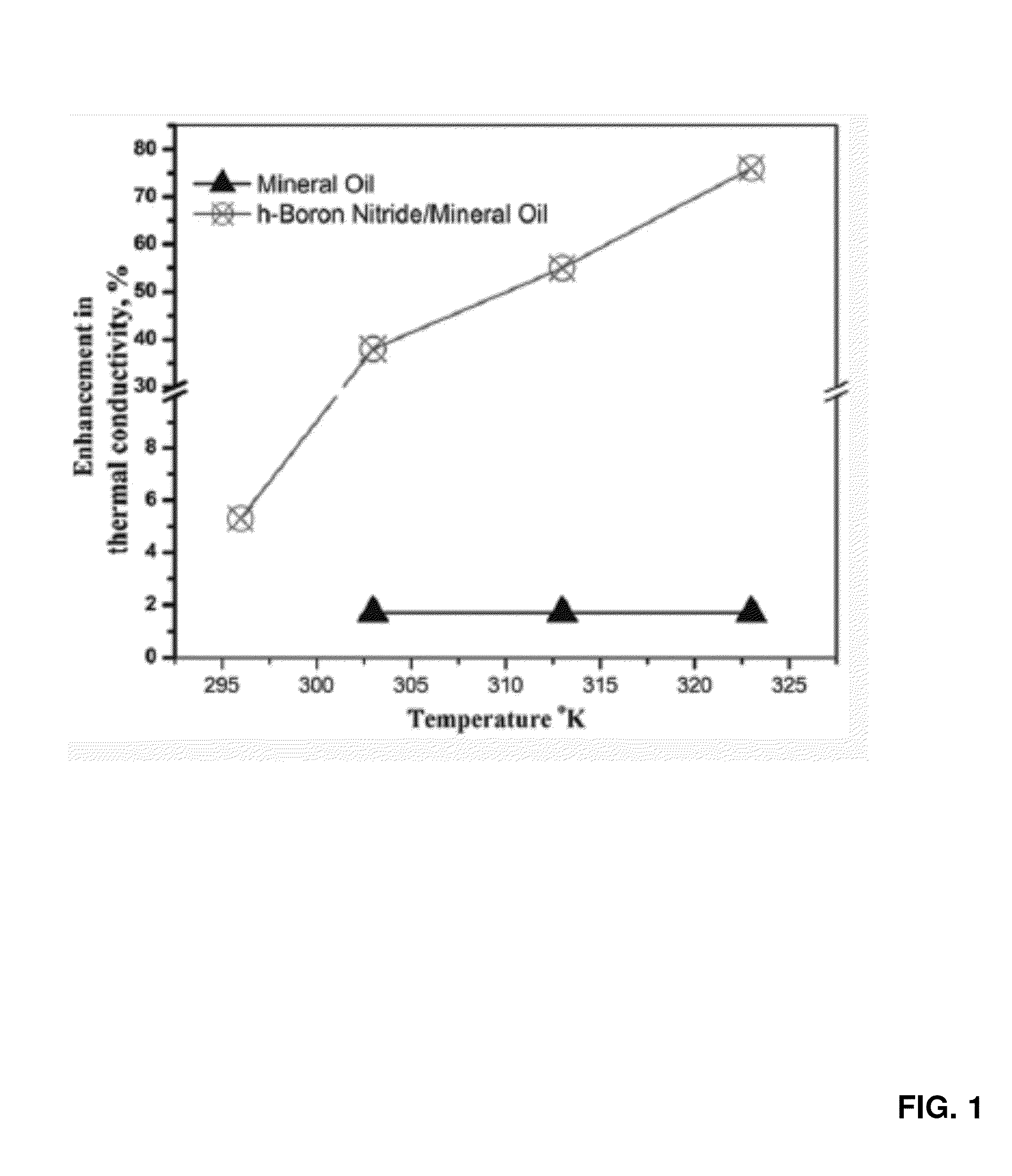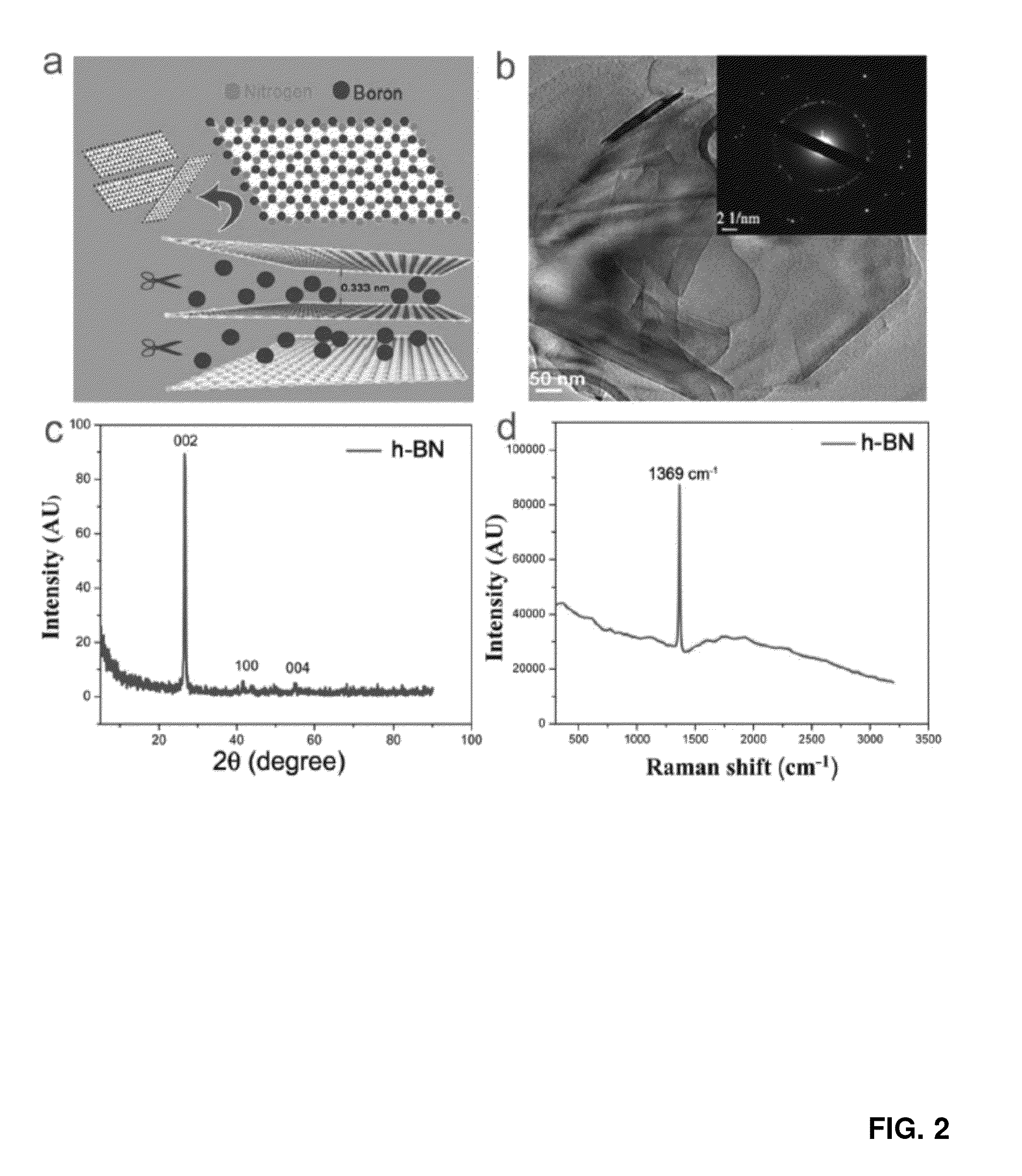Boron nitride-based fluid compositions and methods of making the same
a technology of fluid composition and boron nitride, which is applied in the field of fluid compositions, can solve the problems of interfering with the overall cost effectiveness, and affecting the physical properties of fluids, etc., and achieves enhanced thermal conductivity, reduced coefficient of friction (cof), and enhanced thermal conductivity
- Summary
- Abstract
- Description
- Claims
- Application Information
AI Technical Summary
Benefits of technology
Problems solved by technology
Method used
Image
Examples
example 1
Development and Characterization of h-BN Containing Nanofluids
[0103]Example 1 herein pertains to electrically insulating thermal nano-oils that utilize 2D fillers. Different nanoscale fillers have been used to create composite fluids for applications such as thermal management. The ever increasing thermal loads in applications now require advanced operational fluids, for example, high thermal conductivity dielectric oils in transformers. These oils require optimal filler dispersion, high thermal conduction, but also electrical insulation. Such thermal oils that conform to this thermal / electrical requirement, and yet remain in highly suspended stable state, have not yet been synthesized. Applicants report herein the synthesis and characterization of stable high thermal conductivity Newtonian nanofluids using exfoliated layers of hexagonal boron nitride in oil without compromising its electrically insulating property. Two-dimensional nanosheets of hexagonal boron nitride are liquid ex...
example 1.1
Liquid Exfoliation of h-BN Crystals
[0106]The schematic of liquid exfoliation of micrometer-sized layered h-BN crystals to 2D h-BN nanosheets is depicted in FIG. 2A. The transmission electron microscopy (TEM) of the exfoliated h-BN is shown in FIG. 2B. The h-BN powder is exfoliated into thin layers containing few atomic layers (i.e., 5-10 layers). More TEM and HR-TEM images for further evidence are provided in FIG. 6.
[0107]The corresponding selected area electron diffraction (SAED) is shown in the inset of FIG. 2B. The diffraction rings show the crystallinity of the h-BN layers with rotational disorder. The TEM and HRTEM images of exfoliated graphite (graphene, G sheets) are shown in FIG. 7. The X-ray diffraction (XRD, using Rigaku Cu Ka) pattern of h-BN is depicted in FIG. 2C (that of graphene is provided in FIG. 8). The XRD of dried h-BN nanosheet powders shows a prominent (002) peak indicating a maximum exposure of 002. Raman spectrum of h-BN at 1369 cm−1 originates from E2g mode ...
example 1.2
Preparation of h-BN / MO and Graphene / MO Nanofluids
[0108]Both h-BN / MO and Graphene / MO nanofluids were synthesized by the liquid exfoliation method. The micrometer-sized h-BN powder purchased from Sigma Aldrich (1 pm, 98%) was extensively sonicated (3 h) in isopropyl alcohol (IPA, room temperature surface tension ˜23 mN / m), keeping the temperature (300 K) of the sonicator water bath constant. After sonication, the solution was centrifuged for 30 min with a high rate of 1,500 rpm. The whitish supernatant was collected and vacuum-filtered. The collected white powder was re-dispersed in MO by sonication at room temperature.
[0109]The graphene (G) was prepared by the same liquid exfoliation method using graphitic powder (Bay Carbon, Inc. SP-1 grade 325 mesh). Dimethyl formamide was used as the exfoliation medium (room temperature surface tension ˜37 mN / m). The initial powder was sonicated for 3 h, and the resultant solution was centrifuged at a high rate of 3,000 rpm. The resultant blackish...
PUM
| Property | Measurement | Unit |
|---|---|---|
| TC | aaaaa | aaaaa |
| temperature surface tension | aaaaa | aaaaa |
| temperature surface tension | aaaaa | aaaaa |
Abstract
Description
Claims
Application Information
 Login to View More
Login to View More - R&D
- Intellectual Property
- Life Sciences
- Materials
- Tech Scout
- Unparalleled Data Quality
- Higher Quality Content
- 60% Fewer Hallucinations
Browse by: Latest US Patents, China's latest patents, Technical Efficacy Thesaurus, Application Domain, Technology Topic, Popular Technical Reports.
© 2025 PatSnap. All rights reserved.Legal|Privacy policy|Modern Slavery Act Transparency Statement|Sitemap|About US| Contact US: help@patsnap.com



